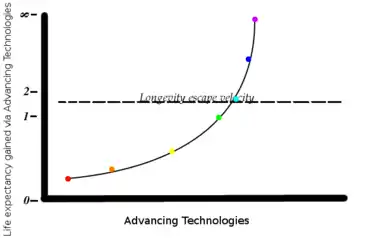Longevity escape velocity
In the life extension movement, longevity escape velocity (LEV) or actuarial escape velocity[2] is a hypothetical situation in which life expectancy is extended longer than the time that is passing. For example, in a given year in which longevity escape velocity would be maintained, technological advances would increase life expectancy more than the year that just went by.

For many years in the past, life expectancy at each age has increased slightly every year as treatment strategies and technologies have improved. At present, more than one year of research is required for each additional year of expected life. Longevity escape velocity occurs when this ratio reverses, so that life expectancy increases faster than one year per one year of research, as long as that rate of advance is sustainable.
Mouse lifespan research has been the most contributive to conclusive evidence on the matter, since mice require only a few years before research results can be concluded.[3][4]
The term "longevity escape velocity" was coined by biogerontologist Aubrey de Grey in a 2004 paper,[3] but the concept has been present in the life extension community since at least the 1970s, such as in Robert Anton Wilson's essay Next Stop, Immortality.[5] The concept is also part of the fictional history leading to multi-century youthful lifespans in the science fiction series The Mars Trilogy by Kim Stanley Robinson. More recent proponents include David Gobel, co-founder of the Methuselah Foundation (MF) and futurist and technologist Ray Kurzweil,[6] who named one of his books, Fantastic Voyage: Live Long Enough to Live Forever, after the concept. The last two claim that by putting further pressure on science and medicine to focus research on increasing limits of aging, rather than continuing along at its current pace, more lives will be saved in the future, even if the benefit is not immediately apparent.[3]
Kurzweil predicts that longevity escape velocity will be reached before humanity will realize it.[7] According to him, as of 2018, it will be reached in 10-12 years.[8]
See also
References
- Aubrey de Grey, A roadmap to end aging. In: TEDGlobal 2005.
- The Futurist. "Actuarial Escape Velocity". The Futurist.
- de Grey, ADNJ (2004). "Escape velocity: why the prospect of extreme human life extension matters now". PLoS Biol. 2 (6): 723–726. doi:10.1371/journal.pbio.0020187. PMC 423155. Retrieved 29 November 2020.
- Dibbell, Julian (October 23, 2006), "The Fast Supper", New York Magazine
- Wilson, Robert Anton (November 1978). "Next Stop, Immortality". Future Life (6). Retrieved 29 November 2020.
- Birnbaum, Ben (2006), "Extension program", Boston College Magazine, archived from the original on 2009-01-16, retrieved 2014-02-08
- Diam, Peter H.; is; MD (2017-11-10). "3 Dangerous Ideas From Ray Kurzweil". Singularity Hub. Retrieved 2020-11-15.
- Koulopoulos, Thomas (2018-01-19). "According to Peter Diamandis and Ray Kurzweil, These Are the Most Dangerous and Disruptive Ideas". Inc.com. Retrieved 2020-11-15.
